8.1 Internal services
SITEWORK STANDARDS
(a) meet the Technical Requirements
(b) take account of the design
(c) follow established good practice and workmanship
Sitework that follows the design and the guidance below will be acceptable for internal services.
INSTALLATION: GENERAL
Items to be taken into account include:
(a) location and fitting of pipes and cables
Service entries through the substructure should be constructed as described in Chapter 5.1 'Substructure and ground bearing floors' (Design and Sitework).
Services should:
- where necessary to prevent damage to the service, be sleeved or ducted where passing through structural elements (not solidly embedded)
- not be located in the cavity of an external wall, except for electricity meter tails
- only be buried in screeds where permitted by relevant codes of practice.
Where copper pipes are permitted in floor screeds they should be :
- sleeved or wrapped so that they can move freely along the length and at joints and bends
- jointed with capillary joints.
(b) jointing of pipes and fittings
Proprietary joints should be made strictly in accordance with the manufacturer's instructions.
Only fluxes recommended by the pipe manufacturer should be used and all traces should be removed immediately after jointing. Fluxes containing lead are not acceptable.
(c) fixing of pipes
Pipes should be adequately secured with suitable clips or brackets. Fixings should be installed neatly and spaced to prevent sagging but not restrict thermal movement. Pipes should have adequate falls, where appropriate.
Sufficient room should be allowed for thermal expansion and contraction to avoid damage and noise from pipe movement.
(d) notching and drilling of joists
SOLID TIMBER
Solid timber joists and studs should only be notched and drilled within the limits shown in the table below:
| Item | Location | Maximum size |
| Notching joists up to 250mm depth |
top edge 0.1 to 0.2 of span |
0.15 x depth of joist |
| Drilling joists up to 250mm depth |
centre line 0.25 to 0.4 of span |
0.25 x depth of joist |
| Drilling studs | centre line 0.25 to 0.4 of height |
0.25 x depth of stud |
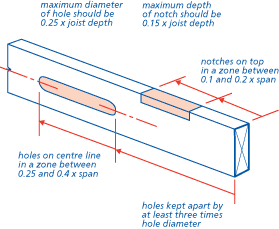
Holes should be kept apart by at least three times hole diameter.
Notches and drillings in the same joist should be at least 100mm apart horizontally.
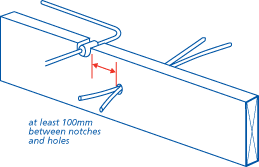
Special instructions should be obtained from the designer when notching and drilling:
- is required in joists deeper than 250mm
- does not meet the above guidelines, or
- is needed close to heavy loads, such as those from partitions, cisterns, cylinders and stair trimming.
If structural strength is impaired by notching or drilling the element should be replaced or correctly repaired.
I-JOISTS
In I-joists pre-formed holes are provided in the timber webs for pipes and cables. Other holes and notches should not be cut without the approval of the manufacturer.
METAL WEB JOISTS
In metal web joists services should run in the gaps between the metal webs. Where services are in conduits, the conduits may have to be inserted before fixing the joists in position. Reference should also be made to Chapter 6.10 'Light steel framed walls and floors' (Sitework).
(e) concealed services
Services concealed in walls or floors should be located so that significant cracking of the surface does not occur.
WALLS
If chases in walls are necessary, their depth should not exceed:
- one-sixth the thickness of the single leaf for horizontal chases
- one-third the thickness for vertical chases.
Hollow blocks should not be chased unless specifically permitted by the manufacturer.
FLOORS
Pipes under floor screeds should, where necessary, be protected by wrapping or ducting. Allowance should be made for thermal expansion, especially at changes of direction
The cover over a pipe or pipes, or any insulating material should be at least 25mm. Where pipes cross over, the screed thickness should still be not less than 25mm and it may be necessary to form a duct to achieve adequate cover. In an in-situ suspended concrete floor, the location and depth should be approved by the designer.
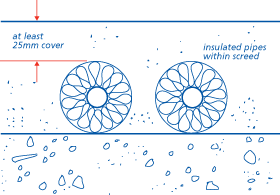
(f) fire-stopping
Fire-stopping should be provided around any services which penetrate fire-resisting floors, walls or partitions. Where a proprietary system, such as an intumescent seal, is used it should be installed in accordance with the manufacturer's instructions.
(g) extract ducts
Extract ducts should have sealed joints and be adequately supported. Ducts passing through unheated spaces, such as a roof void, to the outside air should be insulated or a condensation drain should be provided in accordance with the design.
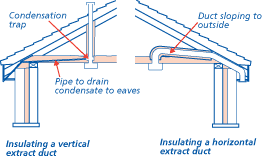
HOT AND COLD WATER SERVICES
Items to be taken into account include:
(a) protection of the incoming service
Any stop valve within the curtilage and outside the dwelling should be protected by a shaft or a box.
Service pipes should be at least 750mm below the ground surface. Where this is not possible, adequate precautions should be taken against frost and mechanical damage.
Any underground duct should be sealed at both ends to prevent the entry of fluids, vermin and insects.
(b) insulation of the incoming service
If the floor is of suspended construction, the underfloor water service should be insulated as it passes through the ground and the ventilated space.
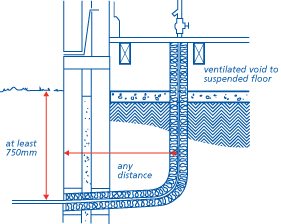
(c) location of meters
If a water meter is built into the external wall of the dwelling, it should comply with Clause S6.
(d) provision of cold water storage
Cold water storage cisterns should have the capacity specified in the design. Adequate support should be provided for the cistern filled with water.
Water cisterns installed in roof spaces should be supported as described in Chapter 7.2 'Pitched roofs' (Design and Sitework). Continuous support should be provided, where necessary, to prevent the cistern bottom being deformed. Suitable materials for support platforms are:
- softwood boarding
- marine plywood
- chipboard Type P5 to BS EN 312
- Oriented strand board Type OSB3 to BS EN 300 laid with stronger axis (as marked on board) at right angles to the bearers.
All water tanks should be accessible. Gangway boarding should be provided from the roof space access opening to each cistern. An area of 1m2 of boarding should be provided next to cisterns to permit routine maintenance. The boarding should be constructed so that ceiling insulation is not compressed.
Water storage cisterns should be protected from contamination by a rigid close fitting cover (which is not airtight) which excludes light and insects.
Holes should be formed with a cutter in the positions shown in the design.
Overflows or warning pipes should be not less than 19mm diameter and situated 25mm from the shut off water level in the cistern. The pipe may dip below the water level in accordance with water regulations. Alternatively, the pipe should terminate vertically downwards or a tee should be fitted horizontally at the discharge end.
(e) hot water storage
Hot water cylinders should be fully supported in accordance with manufacturers' recommendations.
Cylinders should be installed vertically, unless designed otherwise, and should be accessible.
Cylinders should be insulated as specified in the design.
Where an immersion heater is fitted, it should be:
- appropriate for the type of water supplied to the dwelling
- thermostatically controlled
- located so that it can be withdrawn for replacement
- fitted with an on/off switch.
(f) thermal insulation of water services
All water services in unheated spaces, including cisterns and vent pipes, should be insulated against freezing as specified in the design. Insulation should not be placed beneath a cold water tank where it can benefit from heat from below. Raised tanks should be insulated on all sides in an unheated roof space.
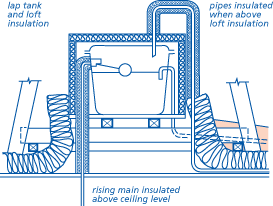
All bends and junctions should be fully insulated, especially near openings to the outside air, such as the eaves, where there is an increased risk of freezing. If possible, water pipes should not be located within the loft space where they could be affected by cold ventilation air.
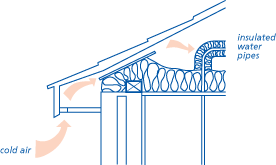
(g) provision for expansion
Vented systems should be provided with an expansion pipe.
(h) unvented hot water systems
Where an unvented hot water system with a storage capacity greater than 15 litres is required by the design, the assembled system with all its components should have independent third party assessment or meet the requirements of BS 7206 with third party assessment such as Kitemarking. Unvented hot water storage systems should be installed by competent installers.
(i) draining down facility
Hot and cold water installations should be capable of being separately drained down.
(j) use of materials
Pipes and fittings for water services should be of materials which are safe and minimise the risk of corrosion. The recommendations of the water supplier as to the compatibility of the water supply with materials and fittings should be followed.
In areas where pitting corrosion of copper cylinders occurs, it may be necessary to fit aluminium protector rods. These should be fitted during manufacture in accordance with the relevant British Standard.
ELECTRICAL SERVICE
Items to be taken into account include:
(a) compliance with Standards
Electrical installations should comply with BS 7671 'Requirements for electrical installations'.
(b) manufacturers' recommendations
Any work involving material or equipment installed as part of the supply or use of electricity should be carried out in accordance with manufacturers' recommendations.
(c) location of electric cables
Cables without special protection, such as an earthed metal conduit, should be positioned as follows:
- vertically from the outlet or switch being served, or
- horizontally from the outlet or switch being served, or
- within the shaded zone in the diagram below, or
- not less than 50mm from the surface of a wall, or
- not less than 50mm from the top or bottom of a timber joist or batten in a floor or ceiling.
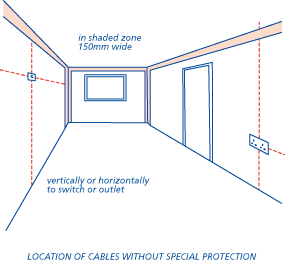
Where the position of switches or sockets can be determined from the reverse side of the wall or partition, the zone on one side of the wall or partition also extends to the reverse side.
(d) location of cables in relation to insulation
Cables should not be placed under, against or within thermal insulation, unless they have been appropriately sized. For further guidance, refer to the BRE Report ‘Thermal insulation: avoiding risks’.
PVC covered cables should not be in contact with polystyrene insulation.
(e) location of socket outlets and switches
Socket outlets and switches on walls should be located in accordance with relevant Building Regulations.
GAS SERVICE
Items to be taken into account include:
(a) compliance with Standards
Service pipework up to and including the emergency control valve and meter should be in accordance with the requirements of the gas transporter, gas supplier and primary meter owner. Installation pipework and appliances should meet with relevant standards and codes including those published by Institution of Gas Engineers and Managers (IGEM) or Gas Safe Register (GSR).
Gas pipework to be installed in timber frame construction should allow for likely differential movement. Reference should be made to Chapter 6.2 'External timber framed walls'.
METERS
EXTERNAL ELECTRICITY AND GAS METERS
Openings for electricity and gas meter cabinets set into external walls should be provided with dpcs and cavity trays.
Except for purpose-designed built-in meter boxes provided by gas and electricity companies lintels are required.
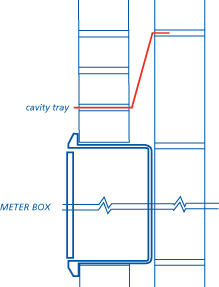
SPACE HEATING
Items to be taken into account include:
(a) location and fitting of appliances
Reference should be made to Chapter 6.8 'Fireplaces, chimneys and flues'.
(b) location of warm air ducts
Warm air ducts for gas-fired air heaters should be installed in accordance with the design, and follow the manufacturer's recommendations.
(c) thermal insulation of heating services
All pipework and ductwork should be insulated as specified in the design.
(d) underfloor heating systems
Detailed guidance on underfloor heating systems is given in BSRIA guides AG12 and 13. Drawings should be made available on site showing the pipe routes.
SOIL AND WASTE SYSTEMS
Items to be taken into account include:
(a) pipework
Soil and waste pipes should be fixed neatly and securely to provide correct falls.
(b) sanitary fittings
Fixings to walls and floors should be appropriate for the weight of fittings. Excess packing should be avoided under sanitary fittings.
All sanitary fittings, cisterns, basin brackets and the like should be fixed with non-ferrous or stainless steel screws or fixings.
(c) sound insulation of pipes
Insulation should be provided to all soil pipes passing through dwellings.
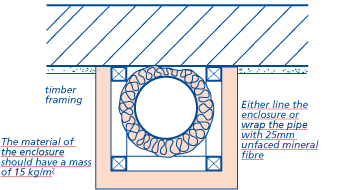
(d) flexible joints/sealants
Junctions with wall tiling around baths and showers on joisted floors should be made with watertight flexible sealant to accommodate movement. The manufacturer's instructions should be followed.
(e) accessories
All specified accessories, such as chains, plugs, etc should be provided and installed. WC lids and seats should be stable when open.
(f) waste disposal units
Waste disposal units should have adequate provision for support and should be fitted with a tubular trap (not bottle or re-sealing) and be connected to the drainage system in accordance with the manufacturer’s instructions.
(g) air admittance valves (AAVs)
AAVs should only be used where specified in the design. They should not be positioned in areas which are liable to freezing.
AAVs require a free movement of air around them which can be achieved by ventilation grilles, discreet gaps around the boxing or ventilation of the boxing into a ventilated roof void. The ventilation area should be not less than 2500mm2 unless otherwise specified by the manufacturer.
TESTING AND COMMISSIONING
Testing should be carried out in accordance with all relevant regulations and codes of practice.
Pipes to be located under screeds should be air or water tested both before and after the screed is laid.
Leaks or other defects should be made good prior to the application of finishes.
Before completion and handover of the building services should be commissioned in accordance with relevant regulations and codes of practice.





















